Aktakom AM-1060 Multimeter – Your Reliable Partner for Every Measurement Task
Looking for a multimeter that’s easy to use, accurate, and built to handle all your everyday electrical tasks? The Aktakom AM-1060 is a fantastic choice for hobbyists, technicians, and professionals alike!
With its compact design and large, easy-to-read LCD display, the AM-1060 makes it simple to measure voltage, current, resistance, and more — whether you’re working on home projects or troubleshooting complex electronics.
Large LCD and bar graph make this multimeter especially useful in education: when measuring signals that change over time, the bar graph can be easier to understand than changing numbers.
AM-1060 Digital Multimeter Features and Benefits
- Large LCD display with bar graph indication and frequency measurement path
- 4000 counts A/D, high resolution
- multi function measurement: DCV, ACV, DCA, ACA, Resistance, Capacitance, Frequency, Temperature, Diode, Continuity beeper
- 10 MOhm input impedance for voltage circuit
- Auto range with manual range selection
- VAHz button, when execute the ACV, ACA function also can measure the frequency of signal
- Max./Min., Peak value, Relative, Data hold
- Meet IEC 1010 CATIII 1000V
Key Advantages:
- Wide measurement range – Accurately test DC/AC voltage up to 1000V, current up to 10A, resistance, frequency, capacitance, and more.
- Auto-ranging function – No need to switch scales manually; the multimeter does it for you, saving time and reducing errors.
- Built-in temperature measurement – Check temperatures with the included thermocouple — perfect for HVAC and automotive work.
- Data hold & backlit display – Easily freeze your readings and work comfortably in dimly lit spaces.
- Protective casing – Durable housing with a soft rubber cover helps guard against drops and bumps.
- Diode & continuity test – Quickly check components and circuits for faults.
| DC Voltage (DCV) | 1000 V |
| DCV Accuracy | ±(0.5%+2) |
| DCV Resolution | 0.1 mV |
| AC Voltage (ACV) | 1000 V |
| ACV Accuracy | ±(1.0%+2) |
| ACV Resolution | 0.1 mV |
| DC Current (DCA) | 10 A |
| DCA Accuracy | ±(1.0%+2) |
| DCA Resolution | 0.1 μA |
| AC Current (ACA) | 10 A |
| ACA Accuracy | ±(1.0%+2) |
| ACA Resolution | 0.1 μA |
| Frequency | 1 Hz...40 MHz |
| Duty Cycle | 0.1%...99.9% |
| Resistance | 0.1 Ω...40 MΩ |
| Capacitance | 1 pF...40 mF |
| Temperature | -20 °C...+750 °C |
| Temperature resolution | 1 °C |
| Diode test | + |
| Continuity check | + |
| Autorange | + |
| Data hold | + |
| Min/Max measurement | + |
| Peak hold | + |
| Relative measurement | + |
| Display | LCD, 4000 counts |
| Bar graph indicator | + |
| Power supply | 1.5 V x 2 batteries |
| Dimensions | 7.6 x 3.5 x 1.6 in / 194 x 89 x 40 mm |
Accuracy tables
"Absolute measurement error" service allows you to estimate the measurement accuracy considering uncertainty (error) in the absolute value. It's important if you take measurements at the range edge when the error value contributes to the value displayed on the device screen. To get the value range it'd be enough to enter the estimate of the value under measurement into Value input field and to see the range of possible values taking all of the standardized errors into consideration. Note: a point is used as a separator of the integer and fractional part. DC Voltage
AC Voltage
DC Current
AC Current
Frequency
Resistance
Capacitance
Specifications
|
Function
|
Range
|
Resolution
|
Accuracy
|
DC Voltage
|
400mV
|
0.1mV
|
±(0.5%reading+2digits)
|
|
4V
|
0.001V
|
±(0.8%reading+1digits)
|
|
40V
|
0.01V
|
|
400V
|
0.1V
|
|
1000V
|
1V
|
|
AC Voltage (50/60Hz)
|
400mV
|
0.1mV
|
±(1.0%reading+2digits)
|
|
4V
|
0.001V
|
|
40V
|
0.01V
|
|
400V
|
0.1V
|
|
1000V
|
1V
|
DC Current
|
400µA
|
0.1µA
|
±(1.5%reading+2digits)
|
|
4000µA
|
1µA
|
|
40mA
|
0.01mA
|
±(1.0%reading+2digits)
|
|
400mA
|
0.1mA
|
±(1.5%reading+2digits)
|
|
10A
|
0.01A
|
±(1.0%reading+2digits)
|
|
AC Current (50/60Hz)
|
400µA
|
0.1µA
|
±(1.5%reading+2digits)
|
|
4000µA
|
1µA
|
|
40mA
|
0.01mA
|
±(1.0%reading+2digits)
|
|
400mA
|
0.1mA
|
±(1.5%reading+2digits)
|
|
10A
|
0.01A
|
±(1.0%reading+2digits)
|
|
Resistance
|
400Ω
|
0.1Ω
|
±(1.0%reading+2digits)
|
|
4kΩ
|
1Ω
|
±(1.5%reading+2digits)
|
|
40kΩ
|
10Ω
|
|
400kΩ
|
100Ω
|
|
4MΩ
|
1kΩ
|
|
40MΩ
|
10kΩ
|
±(3.0%reading+5digits)
|
|
Continuity buzzer: <20Ω ; Max Voltage 500V (DC) / 250V (AC rms)
|
|
Capacitance
|
4nF
|
0.001nF
|
±(3.0%reading+1digits)
|
40nF
|
0.01nF
|
400nF
|
0.1nF
|
|
4µF
|
0.001µF
|
40µF
|
0.01µF
|
|
400µF
|
0.1µF
|
|
4mF
|
0.001mF
|
±(4.0%reading+1digits)
|
|
40mF
|
0.01mF
|
±(12.0%reading+1digits)
|
Frequency (response 1.5V...5V)
|
4kHz
|
0.001kHz
|
±(0.5%reading+2digits)
|
|
40kHz
|
0.01kHz
|
|
400kHz
|
0.1kHz
|
|
4MHz
|
1kHz
|
|
40MHz
|
10kHz
|
Temperature
(K-type)
|
-20°C...300°C
|
1°C
|
±(1.0%reading+2digits)
|
|
301°C...750°C
|
1°C
|
±(3.0%reading)
|
General specifications
- Display: 2.6x2in / 65x48mm large LCD (4000 counts) display with bar graph indication and frequency measurement path
-
Range selection: Auto range with manual range selecting
-
Data hold: To freeze the display reading on the LCD display
-
Memory recall: Records Maximum & Minimum readings with recall
-
Peak value: To measure the signal peak value (>1ms)
-
Relative measurement: To offset the measurement value
-
Polarity: Automatic Switching, "-" indicates negative polarity
-
Zero adjustment: Automatic
-
Sampling time: Approx. 0.5 to 1 second
-
Input impedance: 10Mohm.
-
Operating temperature: 0°C to 50°C (32°F to 122°F)
-
Operating humidity: Max. 80%RH.
-
Power supply: 1.5V battery x 2 PCs UM-4/AAA/Micro/R03 type
-
Power consumption: Approx. DC 1.7mA
-
Dimensions: 7.3x3.5x1.6in / 185x88x40mm
-
Weight: 0.77lb / 350g
Included accessories
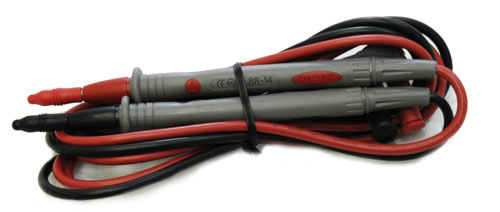
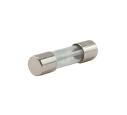
Optional accessories
- Full line adapters: ACA/DCA current adapter, adapter, Tachometer adapter, Humidity adapter, Pressure adapter, Light adapter, EMF adapter, Sound level adapter, High voltage probe
- Soft carrying case
- Temperature probe
DMM basic measurement functions
As an example: oscilloscope diagnostic board AKTAKOM AEE-1017-V1 testing modes are given.
AC/DC Voltage (parallel connection to the circuit) & Current (serial! connection to the break in circuit)
e.g.: sine output (3V/5kHz)
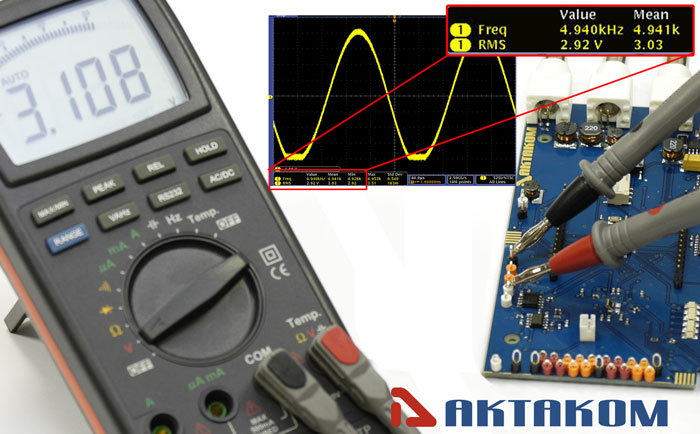
|
AC Voltage Line Frequency ("Hz" button)
e.g.: "FM" output (5kHz)
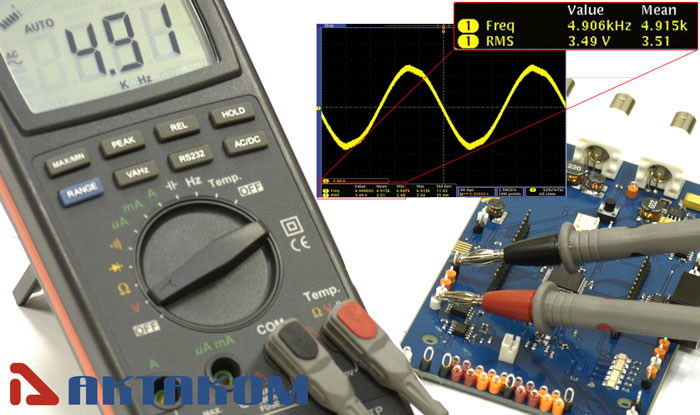
|
Resistance measurement
e.g.: 4.5 kOhm resistor
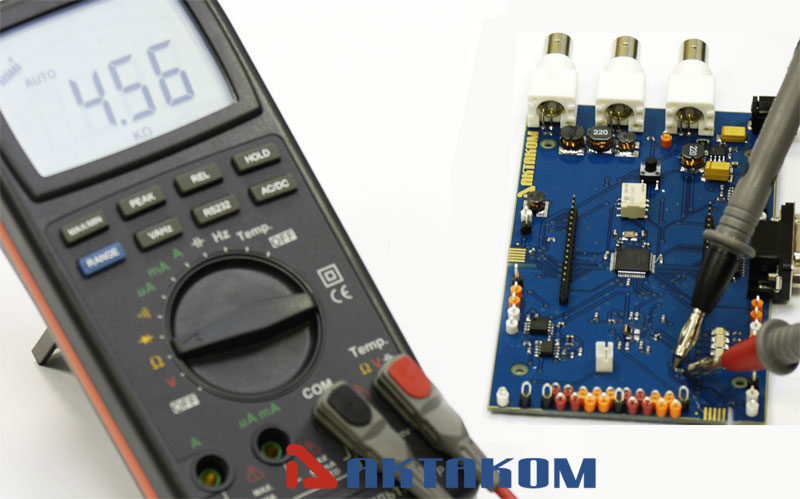
|
Capacitance
e.g.: SMD capacitor

|
Frequency (logic)
e.g.: Counter impulse frequency

|
Continuity (sound buzzer)
e.g.: between different "ground" points of the circuit
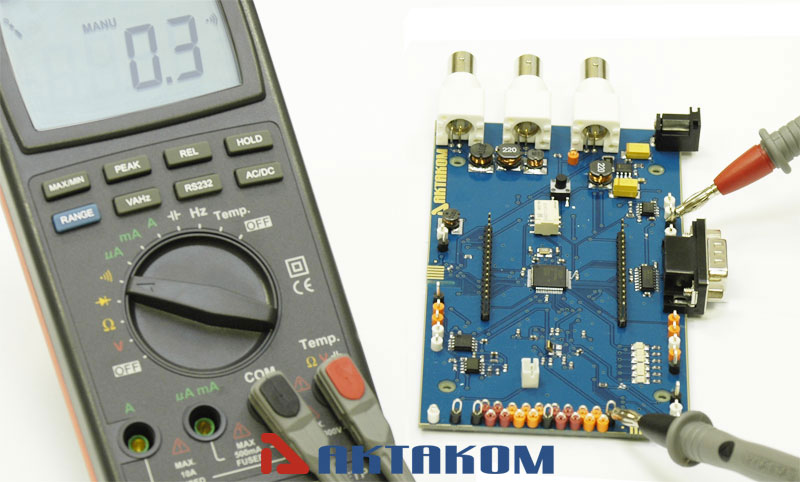
|
Temperature (K type probe)
e.g.: micro-chip surface temperature
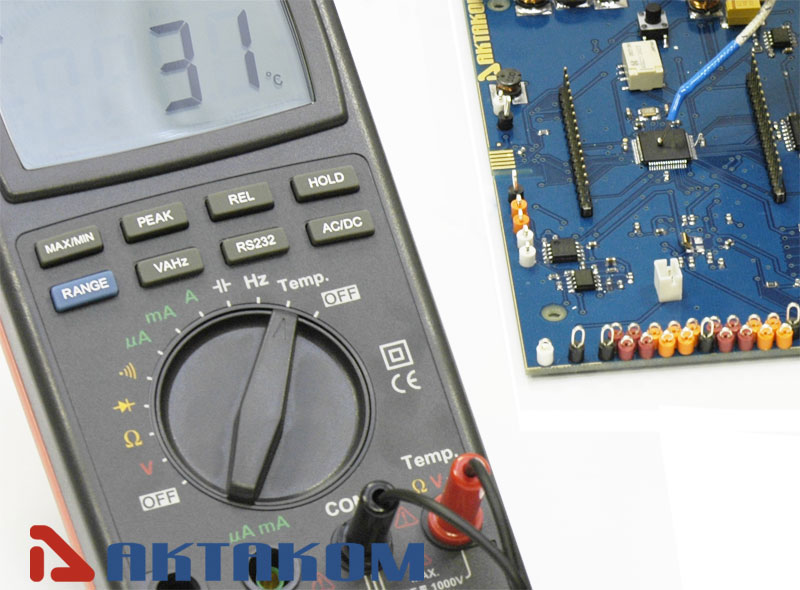
|
Relative measurements (offset)
e.g.: leads resistance compensation

|
Diode test
e.g.: diode forward and backward Voltage drop
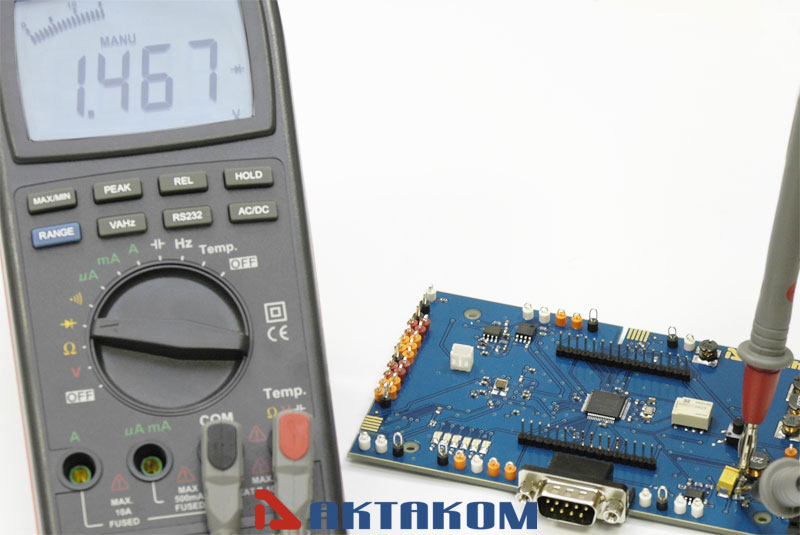 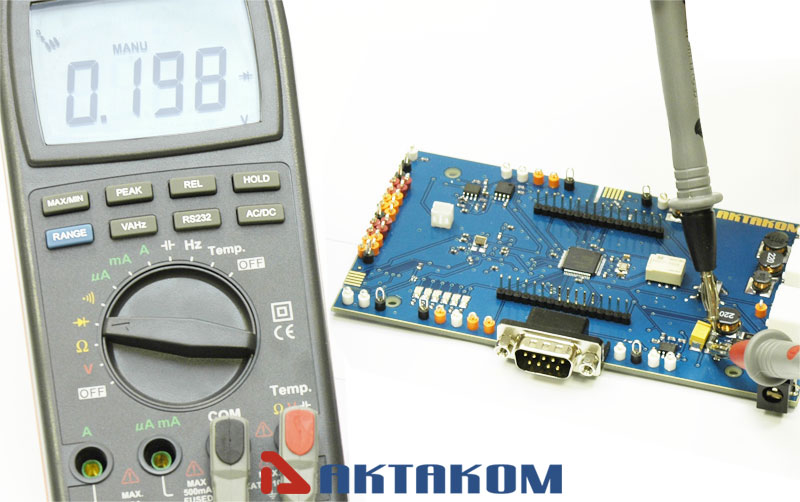
|
Frequently Asked Questions
How is the AM-1060 powered?
Can I measure AC and DC voltage with the same setting?
What is the meaning of CAT II, CAT III, CAT IV?
What’s the difference between analog and digital multimeters?
What is the AM-1060 Digital Multimeter used for?
What is a digital multimeter (DMM)?
What makes the AM-1060 different from a standard multimeter?
Does AKTAKOM AM-1060 multimeter have auto power off function?
How to deactivate Auto Power Off function of AKTAKOM AM-1060 multimeter?
How DMM is designed (disassembled view)
How to replace or install the batteries in AM-1060?
How is the AM-1060 powered?
|
It operates on a 9V battery (6F22 type) and includes an auto power-off feature to conserve energy.
Up
|
Can I measure AC and DC voltage with the same setting?
|
|
No. Always select AC (V~) for alternating current circuits and DC (V—) for direct current. Using the wrong mode can lead to inaccurate readings or damage.
Up
|
What is the meaning of CAT II, CAT III, CAT IV?
|
These are safety categories defined by IEC standards:
-
CAT II: Household appliances, portable tools
-
CAT III: Distribution panels, fixed installations
-
CAT IV: Main service connections and outdoor lines
Up
|
What’s the difference between analog and digital multimeters?
|
Analog multimeters use a moving needle to show readings.
Digital multimeters (DMMs) display numeric values on an LCD screen, offering greater accuracy, readability, and additional features like auto-ranging and data hold.
Up
|
What is the AM-1060 Digital Multimeter used for?
|
|
The AM-1060 is a high-precision digital multimeter designed for electrical, electronic, and laboratory applications. It measures DC/AC voltage and current, resistance, capacitance, frequency, temperature, and includes continuity and diode testing — all in one compact instrument.
Up
|
What is a digital multimeter (DMM)?
|
|
A digital multimeter is an electronic measuring instrument that combines several measurement functions in one unit — typically voltage, current, and resistance. Advanced models also measure capacitance, frequency, temperature, and continuity.
Up
|
What makes the AM-1060 different from a standard multimeter?
|
The AM-1060 offers True RMS measurement, auto-ranging, data hold, relative measurement, and max/min recording features, providing laboratory-grade accuracy for professional and educational use. It also includes USB connectivity for PC data logging, which many standard multimeters lack.
Up
|
Does AKTAKOM AM-1060 multimeter have auto power off function?
|
Yes, it does. There is Auto Power Off function in AM-1060: the device power automatically goes off if you do not use the device within 15 minutes. 30 seconds before the device powers off it will make 3 short sound signals and before powering off – one more long signal. To start the operation again press any button or use the rotary switch.
Up
|
How to deactivate Auto Power Off function of AKTAKOM AM-1060 multimeter?
|
To deactivate Auto Power Off function press RS232 button.
Up
|
How DMM is designed (disassembled view)
|
Front panel covers LCD, button board, rotary function switch gear and main plated circuit board:
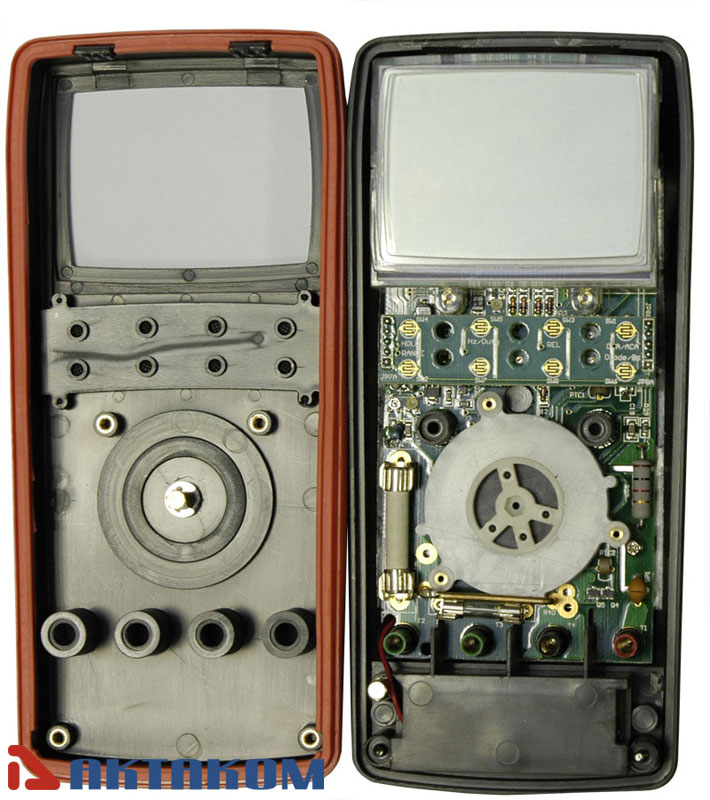
*Rubber strip between the back and front chassis covers protects from water and dust.
Protective fuses are mounted near the inputs and sound buzzer is placed behind the LCD.
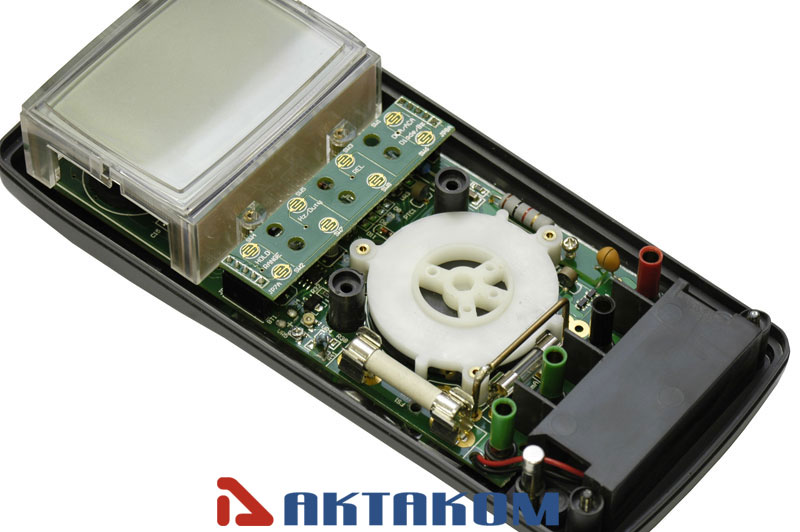
* There is also an extra fuse fixed at the buttom (for several models)
Up
|
How to replace or install the batteries in AM-1060?
|
When the batteries become exhausted or drop below the operating voltage, “BAT” indicator will appear in the LCD display. In this case the battery should be replaced, however in-spec. measurements may still be made for several hours after "Low battery indicator" appears before the instrument become inaccurate.
WARNING! To avoid electric shock, disconnect the test leads from any source of voltage before removing the battery cover.
"DC 1.5V" type AAA (e.g. AM-1060)
1. Open the battery cover by loosing the screws with the cross-point screwdriver
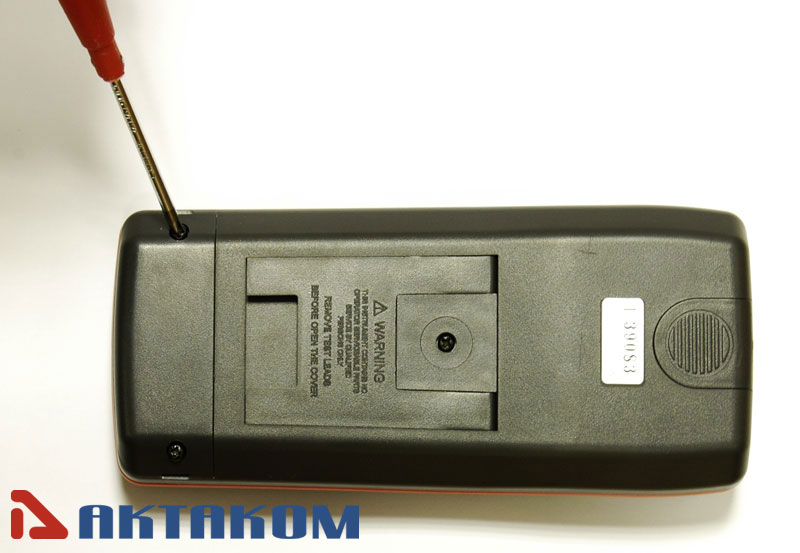  
2. Carefully pull out the buttery carrier and take off the old batteries
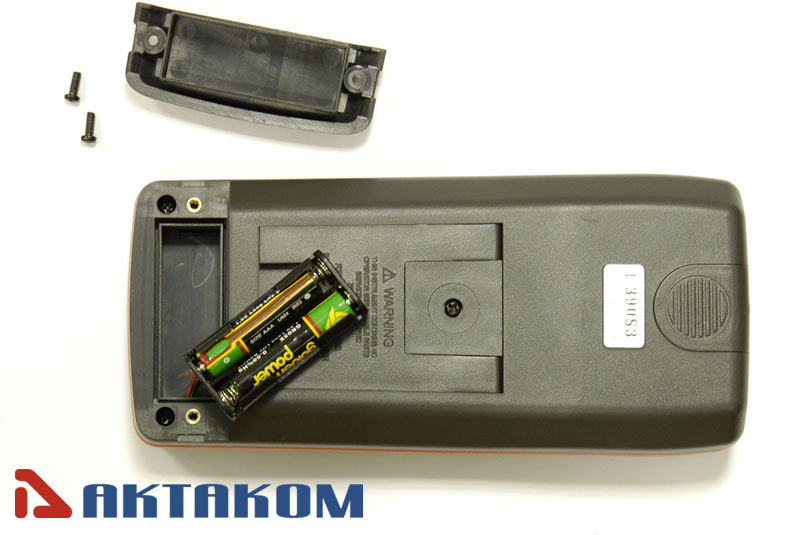 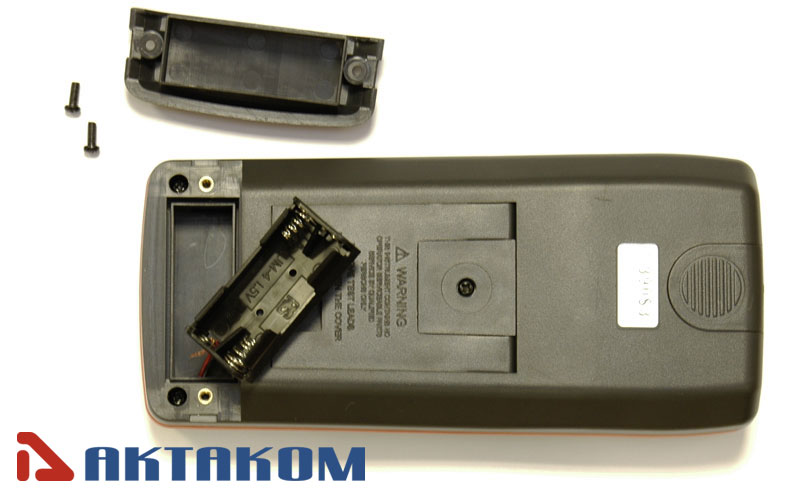
3. Plug the new batteries of the proper type in the holder and put it back
 
4.Close the battery cover and reinstate the cover
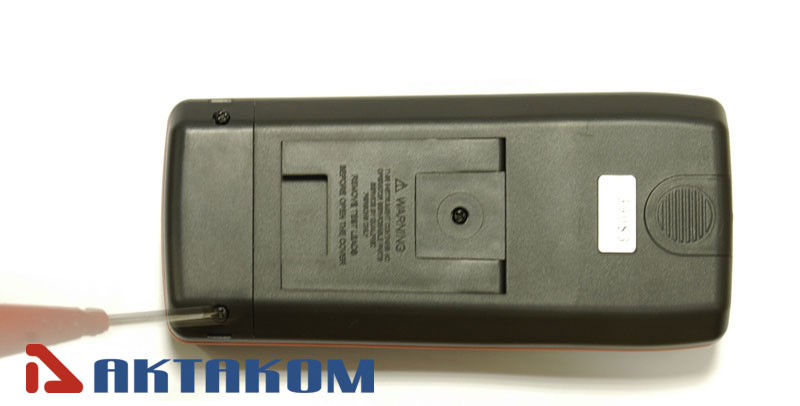 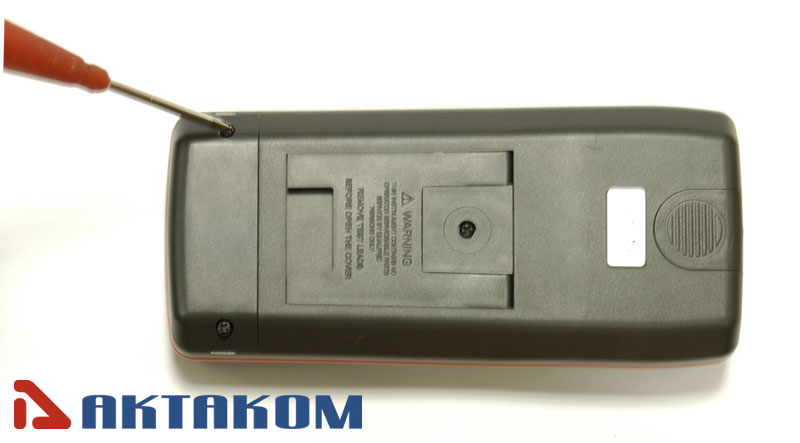
After completion make sure you don’t have any spare parts 
If you do find spare parts, you must start all over 
Up
|
Designing Off Delay Timer Switch for Water Pump Control
Electrical Engineer Shows You How to Fix Your Pool Electrical Supply
LED Repair Tutorial Part 5
How to Use a Digital Multimeter to Test LED Chips
LED Repair Tutorial Part 4
Fixing LED Light Fixture Part 3: Unforeseen causes of broken LED lights
LED Light Driver Repair and Redesign using AKTAKOM AM-1060 DMM
Useful Features of the AKTAKOM AM-1060 Multimeter
How to fix LED light fixture using AKTAKOM AM-1060 DMM, ASE-1209 Soldering Tweezers and APS-7306 Power Supply
How to Use AM-1060 Multifunctional Multimeter
AKTAKOM AM-1060 ofrece multiples funciones de medición como DCV, ACV, DCA, ACA, resistencia, capacitancia, frecuencia, temperatura, testeo de diodos y zumbador de continuidad.
Características
- Cumple con la norma IEC 1010 CAT III 1000V.
- Monitor digital LCD con indicador gráfico de barras.
- Detección de picos con Máximo y mínimo, alternos y retención de datos.
- Auto rango con selección manual de los mismos.
- Termometro °C/°F
- Botón VAHz, cuando se ejecuta la función de ACV, ACA y también puede medir la frecuencia de la señal.
- Alta resolución con 4000 cuentas A/D.
- Fusible incorporado para los rangos de corriente 10 A, mA, uA.
- Impedancia de entrada de 10 M Ohm para el circuito de tensión.
Back to the section
|









